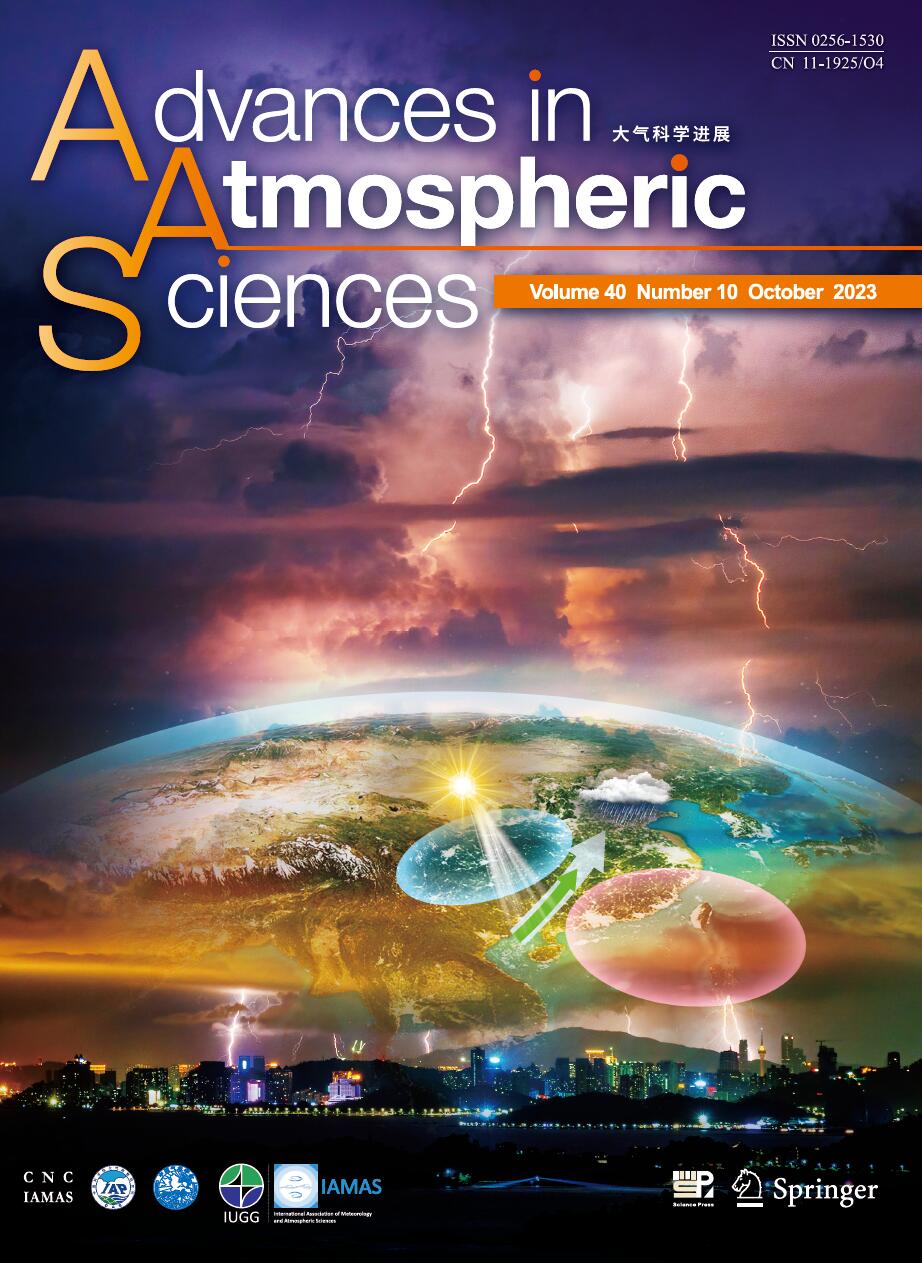| [1] |
Lei ZHU, Chunsong LU, Xiaoqi XU, Xin HE, Junjun LI, Shi LUO, Yuan WANG, Fan WANG,
2024: The Probability Density Function Related to Shallow Cumulus Entrainment Rate and Its Influencing Factors in a Large-Eddy Simulation, ADVANCES IN ATMOSPHERIC SCIENCES, 41, 173-187.
doi: 10.1007/s00376-023-2357-6
|
| [2] |
Peng LIU, Jianning SUN, Lidu SHEN,
2016: Parameterization of Sheared Entrainment in a Well-Developed CBL. Part I: Evaluation of the Scheme through Large-Eddy Simulations, ADVANCES IN ATMOSPHERIC SCIENCES, 33, 1171-1184.
doi: 10.1007/s00376-016-5208-x
|
| [3] |
Shaofeng LIU, Michael HINTZ, Xiaolong LI,
2016: Evaluation of Atmosphere-Land Interactions in an LES from the Perspective of Heterogeneity Propagation, ADVANCES IN ATMOSPHERIC SCIENCES, 33, 571-578.
doi: 10.1007/s00376-015-5212-6
|
| [4] |
Yan ZHENG, Liguang WU, Haikun ZHAO, Xingyang ZHOU, Qingyuan LIU,
2020: Simulation of Extreme Updrafts in the Tropical Cyclone Eyewall, ADVANCES IN ATMOSPHERIC SCIENCES, 37, 781-792.
doi: 10.1007/s00376-020-9197-4
|
| [5] |
Jianjun Xu, Johnny C. L. Chan,
2002: Interannual and Interdecadal Variability of Winter Precipitation over China in Relation to Global Sea Level Pressure Anomalies, ADVANCES IN ATMOSPHERIC SCIENCES, 19, 914-926.
doi: 10.1007/s00376-002-0055-3
|
| [6] |
HAN Bo, LU Shihua, AO Yinhuan,
2012: Development of the Convective Boundary Layer Capping with a Thick Neutral Layer in Badanjilin: Observations and Simulations, ADVANCES IN ATMOSPHERIC SCIENCES, 29, 177-192.
doi: 10.1007/s00376-011-0207-4
|
| [7] |
Wan Jun, Yang Fanglin,
1990: The Phenomena of Bifurcation and Catastrophe of Large-Scale Horizontal Motion in the Atmosphere under the Effect of Rossby Parameter, ADVANCES IN ATMOSPHERIC SCIENCES, 7, 409-422.
doi: 10.1007/BF03008871
|
| [8] |
Yang Fanglin,
1991: The Stability of Large-Scale Horizontal Air Motion in the Non-linear Basic Zephyr Flow under the Effect of Rossby Parameter, ADVANCES IN ATMOSPHERIC SCIENCES, 8, 149-164.
doi: 10.1007/BF02658091
|
| [9] |
Lin Wenshi, Wang Anyu, Wu Chisheng, Fong Soi Kun, Ku Chimeng,
2001: A Case Modeling of Sea-Land Breeze in Macao and Its Neighborhood, ADVANCES IN ATMOSPHERIC SCIENCES, 18, 1231-1240.
doi: 10.1007/s00376-001-0037-x
|
| [10] |
MIAO Shiguang, JIANG Weimei,
2004: Large Eddy Simulation and Study of the Urban Boundary Layer, ADVANCES IN ATMOSPHERIC SCIENCES, 21, 650-661.
doi: 10.1007/BF02915732
|
| [11] |
HUANG Wenyu, WU Rongsheng, FANG Juan,
2010: The Adaptive Wavelet Collocation Method and Its Application in Front Simulation, ADVANCES IN ATMOSPHERIC SCIENCES, 27, 594-604.
doi: 10.1007/s00376-009-8189-1
|
| [12] |
Xia Daqing, Zheng Liangjie,
1986: NUMERICAL SIMULATION OF THE GENERATION OF MESOSCALE CONVECTTVE SYSTEMS IN LARGE-SCALE ENVIRONMENT, ADVANCES IN ATMOSPHERIC SCIENCES, 3, 360-370.
doi: 10.1007/BF02678656
|
| [13] |
ZENG Xinmin, LIU Jinbo, MA Zhuguo, SONG Shuai, XI Chaoli, WANG Hanjie,
2010: Study on the Effects of Land Surface Heterogeneitiesin Temperature and Moisture on Annual Scale Regional Climate Simulation, ADVANCES IN ATMOSPHERIC SCIENCES, 27, 154-163.
doi: 10.1007/s00376-009-8117-4
|
| [14] |
Bangjun Cao, Xianyu Yang, JUN WEN, Qin Hu, Ziyuan Zhu,
2023: Large eddy simulation of vertical structure and size distribution of deep layer clouds, ADVANCES IN ATMOSPHERIC SCIENCES.
doi: 10.1007/s00376-023-3134-2
|
| [15] |
Wu Zengmao,
1987: NUMERICAL STUDY OF LAKE-LAND BREEZE OVER LAKE V?TTERN SWEDEN, ADVANCES IN ATMOSPHERIC SCIENCES, 4, 198-209.
doi: 10.1007/BF02677066
|
| [16] |
Dongxiao WANG, Guojing LI, Lian SHEN, Yeqiang SHU,
2022: Influence of Coriolis Parameter Variation on Langmuir Turbulence in the Ocean Upper Mixed Layer with Large Eddy Simulation, ADVANCES IN ATMOSPHERIC SCIENCES, 39, 1487-1500.
doi: 10.1007/s00376-021-1390-6
|
| [17] |
Guojing LI, Dongxiao WANG, Changming DONG, Jiayi PAN, Yeqiang SHU, Zhenqiu ZHANG,
2024: Frontogenesis and Frontolysis of a Cold Filament Driven by the Cross-Filament Wind and Wave Fields Simulated by a Large Eddy Simulation, ADVANCES IN ATMOSPHERIC SCIENCES, 41, 509-528.
doi: 10.1007/s00376-023-3037-2
|
| [18] |
SONG Fengfei, and ZHOU Tianjun,
2013: FGOALS-s2 Simulation of Upper-level Jet Streams over East Asia: Mean State Bias and Synoptic-scale Transient Eddy Activity, ADVANCES IN ATMOSPHERIC SCIENCES, 30, 739-753.
doi: 10.1007/s00376-012-2212-7
|
| [19] |
Yating ZHAO, Ming XUE, Jing JIANG, Xiao-Ming HU, Anning HUANG,
2024: Assessment of Wet Season Precipitation in the Central United States by the Regional Climate Simulation of the WRFG Member in NARCCAP and Its Relationship with Large-Scale Circulation Biases, ADVANCES IN ATMOSPHERIC SCIENCES, 41, 619-638.
doi: 10.1007/s00376-023-2353-x
|
| [20] |
MIN Wenbin, CHEN Zhongming, SUN Linsheng, GAO Wenliang, LUO Xiuling, YANG Tingrong, PU Jian, HUANG Guanglun, YANG Xiurong,
2004: A Scheme for Pixel-Scale Aerodynamic Surface Temperature over Hilly Land, ADVANCES IN ATMOSPHERIC SCIENCES, 21, 125-131.
doi: 10.1007/BF02915686
|















 AAS Website
AAS Website 
 AAS WeChat
AAS WeChat 
 DownLoad:
DownLoad: